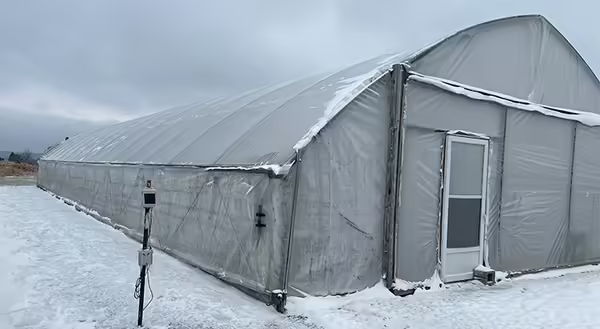
High tunnels are a very productive season extension tool and offer the opportunity for year around growing. While high tunnel environmental management practices tend to focus more on ventilation and air movement during the warm months, wintertime management should not be forgotten. Snow and ice accumulation on the plastic that covers high tunnels adds quite a bit of weight, and if not removed, can be devastating to the whole structure.
Many factors can affect a high tunnel’s ability to withstand ice or snow load and include:
- Location – areas that historically receive quite a bit of annual snowfall compared to areas that rarely receive more than a few inches
- Type and amount of precipitation – dry snow weighs less, is easier to remove and often doesn’t stick to the plastic compared to a wet snow that is heavy and tends to accumulate on the plastic; ice is also very heavy
- Bow spacing – closer spacing between bows increases the structural integrity and allows the high tunnel structure to withstand more snow load
- Trussing – trussing across the bows increases structural integrity substantially and is highly recommended
- Shape of tunnel – gothic style high tunnels have a peaked roof and tend to shed snow and ice more easily than the more rounded Quonset style structures
- Tightness of plastic – stretching plastic tightly across the structure reduces sagging between bows, helping to prevent precipitation accumulation and improve shedding
- Enclosure of tunnel – closing up end walls and side curtains will trap more heat and help reduce accumulation
- Spacing between tunnels – tunnels spaced too close together can be damaged when drifted snow piles can’t be removed and push against the sides
- On-site Management – the most important factor attributed to a high tunnel’s success during a snow or ice event is making sure someone is on-site to monitor the snow load and actively working to keep accumulation to a minimum
Being prepared to manage snow or ice accumulation before inclement weather hits is the best way to reduce the risk of potential high tunnel loss. Remove any shade cloth material from the outside of the tunnel as snow and ice can accumulate quite easily on the porous material compared to the slick surface of the plastic. Snow removal techniques can include brooming off from the outsides; attaching soft bristled or padded broom heads on extendable poles and pushing up on the plastic from the inside, being carefully not to puncture the plastic; running forced air type heaters inside the tunnel; and any other means that can shed snow. Don’t wait until after a snow or ice event to begin the removal process as this may put the whole structure at risk of collapse. Depending on your high tunnel structure, an inch or two probably isn’t going to cause damage but additional accumulations could become problematic and when considering the economic investment and potential returns, it is better to be safe than sorry.